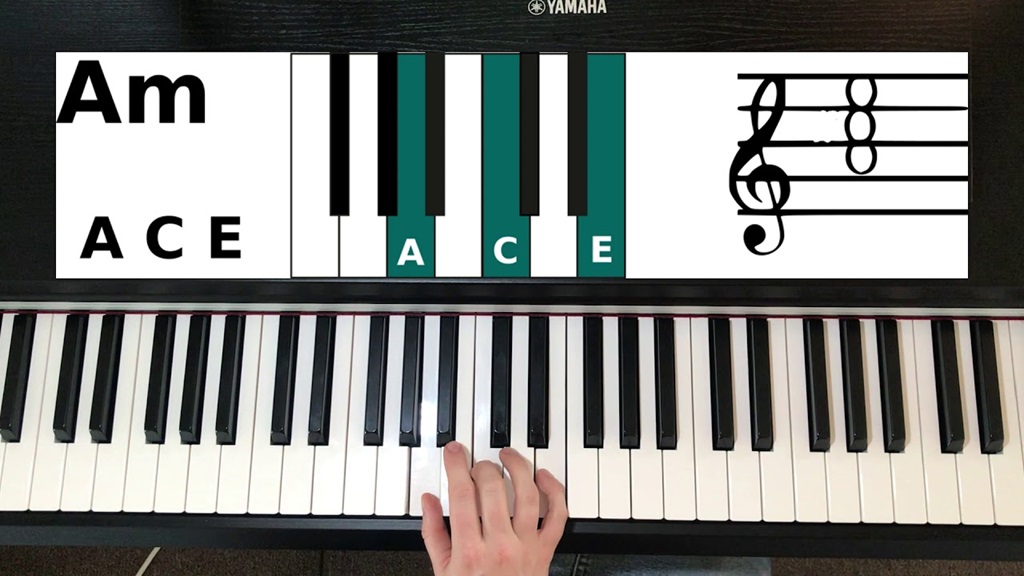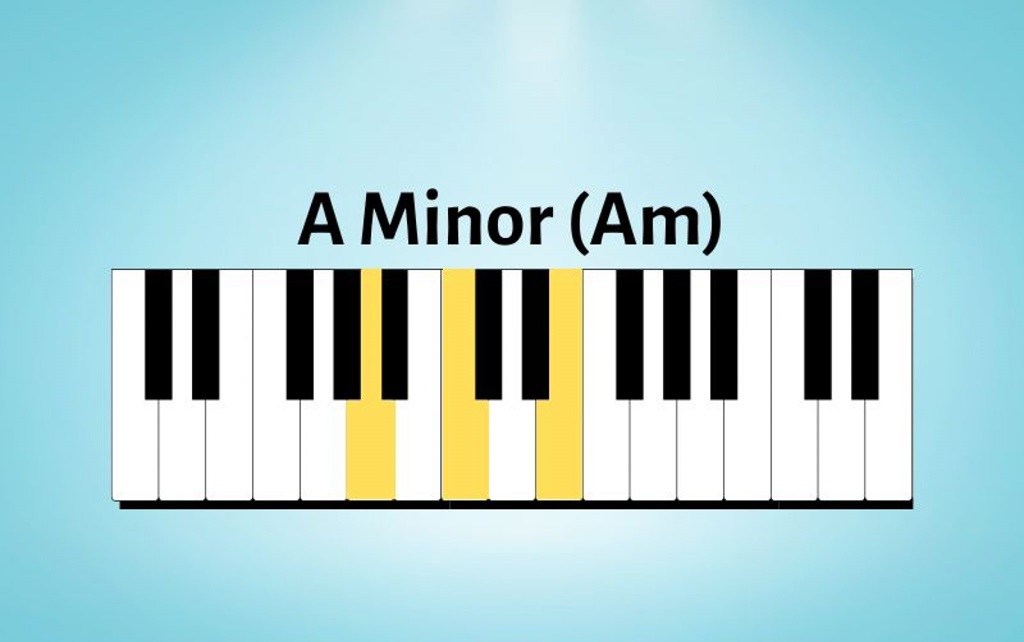
21 Dec How to Play Am Piano Chord
Playing piano chords can open up a world of possibilities when it comes to making music. One of the most commonly used chords is the A minor or Am chord. Understanding how to play an Am piano chord on piano is an important skill for any pianist to have. In this comprehensive guide, I’ll walk through everything you need to know about the Am chord, from the basic structure to tips on how to use it when playing songs.
What is the Am Piano Chord?
The Am chord is a minor triad, meaning it consists of three notes – the root note (A), the minor third (C), and the fifth (E). On a piano keyboard, an Am triad spans four white keys: A, C, E, and A one octave higher. The combination of these three notes played together produces the signature moody, melancholic sound that minor chords are known for.
Though it has a somber tone, the Am chord is extremely common in many styles of music, especially pop, rock, and blues. Any time you see a chord symbol with just the letter “A” followed by a lower case “m” (Am), that indicates you should play an A minor triad.
Understanding the Am Chord Construction
To get more familiar with the Am piano chord construction, let’s break down the interval structure:
- Root – The root note of the chord, which is A. This is the base note that gives the chord its name. On piano, the root A note is located one semi-tone above G#.
- Minor 3rd – Counting up three semi-tones from the root A brings you to the next note, C. The interval between the root and this note is called a minor third, which gives minor chords their distinctive moody quality.
- Perfect 5th – Starting from the root A, if you count up seven semi-tones you reach E. The A to E interval forms a perfect fifth. This five semi-tone distance is what anchors the chord.
So in summary, from bottom to top, an Am triad contains the notes A – C – E. Understanding the unique spacing of minor thirds and perfect fifths is key when learning any minor chord, including Am.
How to Play an Am Chord on Piano

Fortunately, playing an Am triad on piano is simple since you can use all white keys. Follow these steps:
- Locate the A note on your keyboard. This will most likely be the white key to the right of the group of two black keys.
- With your thumb, press and hold down the A key.
- Identify the C note, which is three white keys (or three semi-tones) up from A. Use your middle finger to press the C key.
- From the A note, skip over another white key to land on E. Press down E with your pinky finger.
You should now have a three note Am chord with your thumb, middle finger, and pinky holding down A, C, and E simultaneously.
To play the chord cleanly, keep these piano playing tips in mind:
- Sit with proper upright posture and keep your wrists level with the keys
- Use the weight of your arms, not just your fingers, to depress the notes
- Keep fingers curved and play on the tips for better control
- Listen for all three notes to ring clearly without any muted notes
Once you’ve mastered the basic Am triad shape, try moving it around the piano to play A minor in all octaves and inverted positions.
Playing Am Chord Inversions
Like most chords, the Am triad has two other inverted forms besides the common “root position” we learned above. Being comfortable with these other Am shapes will give you more options when playing songs.
The first inversion of an Am puts the C note on bottom instead of A. To play:
- Locate C with your thumb
- Position your middle finger on E
- Place your pinky on the top A note
For the second inversion, the E becomes the lowest note in the chord:
- Thumb on E
- Middle finger plays A
- Pinky plays high C
Practice slowly transitioning between the root position, first inversion, and second inversion of Am. Listen carefully to connect the sound of each voicing by ear. Having flexibility with Am chord inversions will help you play more advanced piano songs and arrangements.
Building Am Chord Variations
The basic minor triad is just the starting point when it comes to Am chords. Let’s look at some of the most popular Am piano chord variations:
Am7 – This jazzy chord adds in a minor 7th for more flavor. The four notes are: A C E G#.
Am/C – In this variation, C becomes the bass note instead of A, creating a suspended feel. Notes are C E A.
Am/E – Similar to Am/C but now E becomes the lowest note in the chord. Play E A C.
Am(add9) – Includes the 9th note relative to the root (one octave higher than the root). Notes = A C E B.
Am7(add11) – Builds on the Am7 sound by adding an 11th. Notes are A C E G# D.
There are endless possible Am chord variations to experiment with by adding extensions like the 9th, 11th, and 13th. Exploring different Am voicings will expand your piano chord vocabulary.
Playing Songs Using the Am Chord
Now that you know how to build the Am chord, let’s look at how to apply it to playing actual music. The Am triad fits nicely into basic chord progressions backing pop, rock, blues, and jazz songs.
Here are just a few classic song examples that prominently feature Am chords:
- “Wonderwall” by Oasis
- “Dust in the Wind” by Kansas
- “With or Without You” by U2
- “Mad World” by Tears for Fears
- “Creep” by Radiohead
- “Under the Bridge” by Red Hot Chili Peppers
When playing these songs on piano, pay attention to how long to hold each Am chord, if you need to play inversions, and when to transition to other chords like G or F. Understanding rhythm and chord changes takes practice, so don’t get discouraged!
You can also play simple three or four chord songs just using Am, C, G, and F chords. For example the progression Am, C, G, F contains the essential “I-IV-V-vi” chord movement heard in tons of popular songs through the decades. Get creative playing patterns mixing up these chords in various orders to create your own Am chord backed song on piano!
Tips for Playing More Advanced Am Chord Voicings

If you’re ready to take your Am chord piano skills up a notch, here are some tips for playing more advanced voicings:
- Spread out the notes over a wider range by utilizing gaps and inversions
- Include colorful extensions like the 7th, 9th, or 13th
- Enhance chords with added non-chord tones for suspensions and tensions
- Play left-hand rootless chord voicings in mid to high register
- Use “drop 2” or “drop 3” Am voicings for fuller sounding chords
- Try polychord harmonies like Am over C or Am over E
- Layer contrasting dyads, arpeggios, and melodic lines on top of Am chord
By mastering these advanced chord techniques over Am, you can emulate the dynamic, sophisticated chord textures of the pros. Don’t limit yourself to just basic Am triads – take your Am chord piano playing skills as far as your creativity will allow!
FAQs
Why is the Am chord so popular in music?
As a minor chord, Am has an inherently melancholy and serious emotional sound that resonates with listeners. These moodier minor chord qualities perfectly capture more somber or introspective lyrical themes in pop, rock, folk and film scores. Additionally, the simplicity of the Am shape on piano makes it very accessible to use.
How do I commit the Am chord structure to memory?
It’s all about repetition! Focus on consistently identifying and playing the interval pattern of minor 3rd + perfect 5th that constructs an Am triad. Say the notes “A – C – E” outloud each time you play an Am. Over time, the muscle memory of this chord shape will stick.
Should my fingers arch when playing the notes in an Am chord?
Yes, it’s best to keep a rounded shape in your fingers and play with the fleshy tips. This avoids accidentally muting notes and helps play cleanly. Keep knuckles bent and wrists loose while playing the triad. Avoid a flat palm.
What are the best songs for beginners to practice Am chords?
Some great starter songs would be “Wonderwall” by Oasis, “Zombie” by The Cranberries, “Dust in Wind” By Kansas, or any I-IV-V blues-based tunes. Focus on getting used to the feel and sound of moving between Am triads and other major / minor chords.
Is there any simple way to memorize all the Am chord inversions?
The easiest way is to logically relate the inversions back to major chord shapes you already know. For example: The second inversion Am triad has the shape and sound of a C major chord. The first inversion Am resembles an E minor chord. Making these types of connections can help reinforce inversions.


Sorry, the comment form is closed at this time.